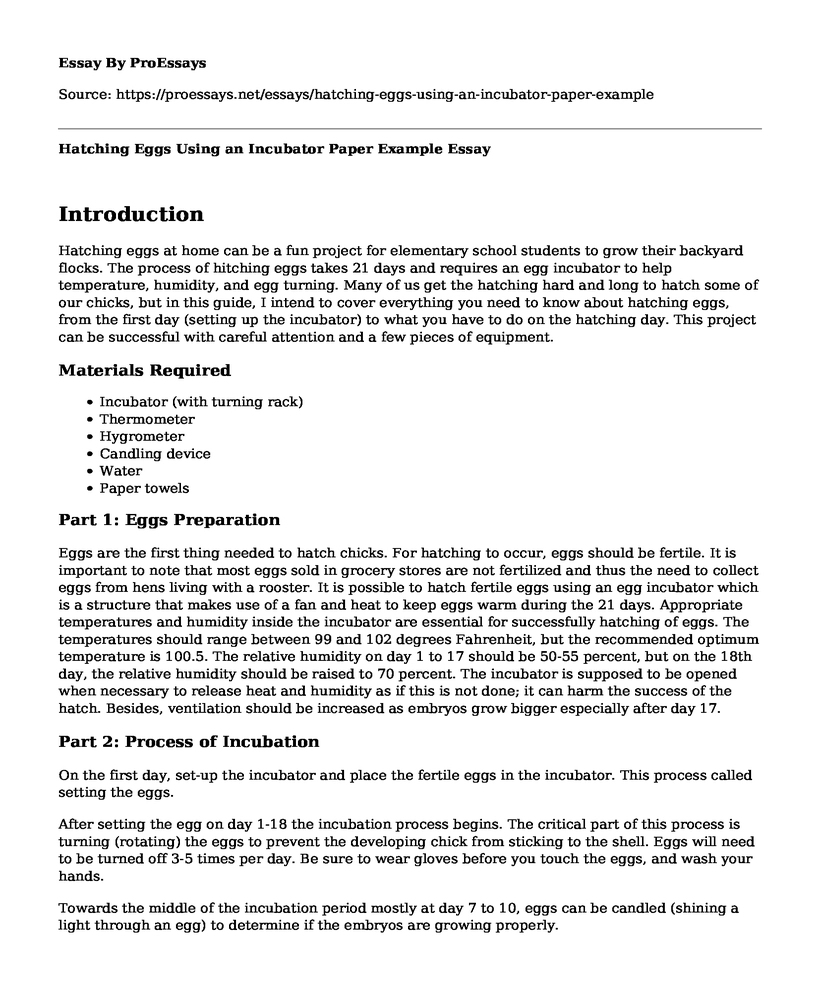Introduction
Hatching eggs at home can be a fun project for elementary school students to grow their backyard flocks. The process of hitching eggs takes 21 days and requires an egg incubator to help temperature, humidity, and egg turning. Many of us get the hatching hard and long to hatch some of our chicks, but in this guide, I intend to cover everything you need to know about hatching eggs, from the first day (setting up the incubator) to what you have to do on the hatching day. This project can be successful with careful attention and a few pieces of equipment.
Materials Required
- Incubator (with turning rack)
- Thermometer
- Hygrometer
- Candling device
- Water
- Paper towels
Part 1: Eggs Preparation
Eggs are the first thing needed to hatch chicks. For hatching to occur, eggs should be fertile. It is important to note that most eggs sold in grocery stores are not fertilized and thus the need to collect eggs from hens living with a rooster. It is possible to hatch fertile eggs using an egg incubator which is a structure that makes use of a fan and heat to keep eggs warm during the 21 days. Appropriate temperatures and humidity inside the incubator are essential for successfully hatching of eggs. The temperatures should range between 99 and 102 degrees Fahrenheit, but the recommended optimum temperature is 100.5. The relative humidity on day 1 to 17 should be 50-55 percent, but on the 18th day, the relative humidity should be raised to 70 percent. The incubator is supposed to be opened when necessary to release heat and humidity as if this is not done; it can harm the success of the hatch. Besides, ventilation should be increased as embryos grow bigger especially after day 17.
Part 2: Process of Incubation
On the first day, set-up the incubator and place the fertile eggs in the incubator. This process called setting the eggs.
After setting the egg on day 1-18 the incubation process begins. The critical part of this process is turning (rotating) the eggs to prevent the developing chick from sticking to the shell. Eggs will need to be turned off 3-5 times per day. Be sure to wear gloves before you touch the eggs, and wash your hands.
Towards the middle of the incubation period mostly at day 7 to 10, eggs can be candled (shining a light through an egg) to determine if the embryos are growing properly.
The chicks will hatch on the 21st day, but if the eggs don't get enough heat during the incubation period, the process might take a little longer. Therefore, if the chicks do not hatch on the 21st day, it will be important to wait for a few more days.
Ensure that only clean eggs are kept in the incubator for hatching. Avoid washing or wiping eggs with a damp cloth. Besides, the fertile eggs will not hatch at once, but they are usually all done within 24 to 48 hours of first hatching. However, some hatches can last up 4-5 days.
Conclusion
The process of hatching eggs using an incubator is a great experience if done with proper planning and equipment. During the process, it is essential to keep a watchful eye on temperatures and humidity inside the incubator as well as invite your friends to show them your work and enjoy your project. Good Luck.
Cite this page
Hatching Eggs Using an Incubator Paper Example. (2022, Nov 28). Retrieved from https://proessays.net/essays/hatching-eggs-using-an-incubator-paper-example
If you are the original author of this essay and no longer wish to have it published on the ProEssays website, please click below to request its removal:
- Legislative Approach Taken to Control Waste Water in Trinidad and Tobago and That Taken in South Korea
- Research Paper on Ecology: Deforestation, Its History and How It Affects Our Ecosystem
- Essay Example on the Climate Change
- Carbon Footprint Calculators Essay
- Essay Sample on Non-Governmental Organizations' Roles in Disaster Management
- Essay Sample on Animal Testing for Cosmetics: Cruelty or Necessity?
- Green Emergency: Deforestation Challenges and Legal Perspectives in Pakistan - Free Report







